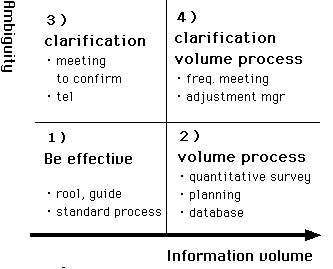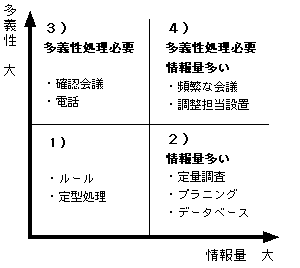Product Realization Strategy
Impact of 3D-CAD Technology at manufacturing
Cat: ICT
Pub: 2000
#: 0009a
Yoko Takeda
00630u/18205r
Title
Product Realization Strategy
プロダクト・リアライゼーション戦略
Author
Yoko Takeda
竹田陽子
Published
Jun. 2000
2000年6月
Index
Tag
; Agent for the client; CALS; Enacting; Front Loading; Information richness; Modular architecture; Process design; Processing function; Rapid prototyping; Solid modeler; Value packager;
Why?
- The first glimpse of 'Rapid Typing' in 1997 became ignition of
the author's interest of this theme.
- New generation of three-dimension CAD (3D-CAD) has the feature
of arousing communication, which may cause discontinuous changes;
change of process, organization and even structure of the industry.
- Manufacture is not a simple physical fabricator of the materials.
It is the industry who creates the defined information of what to
make (=product) and how to proceed it (=process).
- Japanese manufactures, believed the strongest in the world, should
utilize the potentiality of 3D-CAD technology as well as Internet.
- 著者によれば、1997年にラピッド・プロトタイピングを見たことがこのテーマに興味をもったきっかけであったとのこと。
- 新世代の三次元CADは、人々のコミュニケーションを喚起する性質があり、これによる不連続な変化、即ち、プロセスが変わり、組織が変わり、産業構造が変わる可能性がある。
- 製造業とは、単に材料を物理的に加工するのではなく、何を作るか (製品) 、どのように作るか (工程) を定義する情報を生み出す産業である。
- 物作りに強い日本企業は、この三次元情報技術やインターネットのポテンシャルを戦略的に活かすべきである。
Summary
要約
>Top
1. Three-dimension
CAD:
- In the field of production, it is now in the process of new technological
revolution of such as 'Rapid prototyping'. This may lead to changes
of development process, its organization, and structure of the industry.
- In particular, 3D-CAD steadily diffused since 1992-93, replacing
already saturated 2D-CAD technology.
- 2D-CAD technology maneuvers complicated description of primary
3D product, but it is not easy even for a specialist to grasp the
exact image of the product.
- >Top New generation of 3D-CAD technology appeared in the end of 1980s
in Japan, which is called 'Solid modeler' having the inner structural
data, thus we can distinguish inside and outside of the surface,
calculated volume and weight, and use as a design tool. 3D-CAD also
has 'feature function' which can automatically keep 3D shape and
'parametric function' which can change the size of 3D shape by parameters.
- Example: If we give a 'feature' as a 'hole', which maintains
a hole even changed in thickness, and diameter of the hole can
be easily changed by 'parameters'.
- Though number of the trials are decreased, the importance of
actual modeling is unchanged, because of the fabrication, strength,
performance, functions, operability and texture of the material
can be recognized and confirmed.
1. 三次元CAD:
- 現在、製品開発の分野では、Rapid prototyping (試作の高速造形) など情報技術の革新が起こっており、これによって開発プロセスも、組織も、産業構造も変わり得る。
- 特に三次元CADは、1992 - 93年頃より、二次元CADの飽和状態に代わって普及し始めた。二次元CADは、本来三次元の製品を三方向から描くもので、専門家にとっても製品の正確なイメージは掴むことは容易ではない。
- 1980年末に登場した新世代三次元CADは、"Solid modeler" と呼ばれ、三次元の内部構造をデータとして持つので、輪郭・表面だけでなく表裏の区別、容積・重量計算ができ、設計のツールとして使われるようになった。また、立体の形状を自律的に保つフィーチャ機能と、立体のパラメータを数値入力することで変形できるパラメトリック機能を備えている。
- 例:「穴」というフィーチャを与えれば、立体の厚みを大きくしても穴は貫通したまま。またパラメトリック機能によって、穴の直径を自由に変えられる。
- なお、三次元CADの登場で回数は減るものの、試作品を作ることはなくならないだろう。それは、組立性、強度、性能、機能確認、操作性・質感などでやはり作ってみないとわからない。
>Top
2. 'Processor function'
and 'Media function':
- Processing function:
functions of information technology which a sender of the information
treats or converts to coded information, transmits, edits and stores
it. This is the function 'to automate': This function is displayed
the result of process or calculation in a definite format excluding
ambiguity by interpretation.
- Media function:
functions supporting to transmit or convey the meaning or the
will of the sender. In this function interpretation of the data
depends to the receiver's response.
(This is a function of 'to informate'.)
- >Top Cf: "information richness" is defined as a function to
enable information to change understanding within a time interval.
- Remarks: 3D-CAD has both 'processor function' and 'media function'.
2. プロセッサ-機能とメディア機能:
- プロセッサー機能:
情報の送り手が、予め定めた手順に従って、コード化、伝送、加工、蓄積処理を行う情報技術の機能をプロセッサー機能 (Programmed
processing function) という。(いわばautomateの役割)
特徴:これは意味の解釈の余地なく、定型的な演算処理、一定のフォーマットによって表示される。
- メディア機能:
これに対し、データの意味解釈が受け手の反応に委ねられ、人と人とが相互作用によって意味や意思を伝達することを支援する機能をメディア機能と呼ぶ。
(いわばinformateの役割)
- 関連概念:"information richness" とは、情報が一定時間内に理解を変えることができる程度
- なお、三次元CADは、プロセッサー機能とメディア機能を併せ持つ。
>Top
3. "Front Loading":
- One of the best benefit of using 3D-CAD is to minimize development
period as well as cost by using the 'media function', with which
various designing problems can be recognized and be solved at the
earlier stages between intra-corporate and extra-corporate communications.
This is called 'Front Loading' effect.
- Usal problem-solution cycle is: Recognition → Alternatives → Modeling
→ Test → Evaluation and such repetition of all.
'Media function' affects In the above former processes, and 'processor
function' in the latter; according to the the author's six case
studies the downstream division submit their professional opinions
during definition of the product and the process are still fluid,
and conversely the output information from the upperstream division
to the downstream division is clearly transmitted, minimizing adjustment
to exclude ambiguity or supplement with the instruction.
- According to the survey, Front loading' is typically observed
through participation to the designing as well as official and non-official
meeting; thus product quality is improved and shortening of the
product period is performed in most of the cases.
- Remarks:
- >Top *1: If physical structure and its function of the product
correspond one to one, and if there is a interface which can
separate into each component, it is called as 'modular architecture',
while if there is no such features, it is called as 'integral
architecture'. The latter product compared to the former becomes
more difficult in parallel production of each module.
- *2: Such a person called 'Boundary role person' is useful
as cased, who functions as an interface chewing outside information
and distributing to the internal organization.
- Provided however, by using 3D-CAD, the development processes rather
increased, and relation of original designer and designing engineer
becomes blurry, in addition a new type of expert who has the interface
with customers will appear in such a new environment. This could
be a new trend for change of the outsourcing business and industrial
structure by the new 3D technology.
3. フロント・ローディング:
- 三次元CAD活用の最大のメリットは、メディア機能を活用した企業内・企業間での設計上の諸問題を早い段階で認識し解決することによって開発期間短縮とコスト削減を図ることである。これを「Front
loading」という。
- 問題解決のサイクルとして、問題認識→代替案→モデル作成→テスト→評価の繰り返しの作業となる。前段ではメディア機能が、後段ではプロセッサー機能が作用し、著者に依る6件の事例研究によれば、下流行程部門は、上流行程部門に、まだ製品や行程の定義がまだ流動的である段階から、自らの専門性からの意見を伝え、上流行程のアウトプットに影響を与える。
一方、製品データの厳格な定義を行う三次元情報技術のプロセッサ-機能によって、上流部門の問題解決のアウトプットを下流部門に伝達する機能も同時に強化し、指示のあいまいさを補完するための相互調整は減少する。
- このように、設計への参加や公式・非公式会合などを通じてFront loadingは典型的に現れた。そして多くの場合、製品品質は向上し、期間短縮は達成されたことが報告されている。
- <注>
- *1) 製品の物理構造と機能とが1対1に対応し、各コンポーネントが分離できるインターフェイスを持っている場合 (modular
architeccutre) と、分離していない場合 (integral architecture) とは、前者に比べ後者は、製品部位単位での課業分割が行いにくくなる。
- *2) 外部情報を咀嚼して組織内に広める役割を果たす、コミュニケーションの結節点にいる対境担当者 (boudary
role person) の役割もあり得る。
- 但し、開発工数は短期的にはむしろ増えることも報告された。またデザイナーと設計者の分業関係が曖昧になり、顧客とのインターフェースが要求され、新しいタイプの職人が出現するなど分業構造、産業構造が変わる傾向がある。
>Top
4. Information
and ambiguity

- Volume of information and volume of ambiguity constitute the following
four interpretation modes:
- 1) Less information & less ambiguity case: "Conditioned
viewing"
Analysis of environment is possible but the organization
is passive, and information is processed according to the patterned
format:
- 2) More information & less ambiguity case: "Discovering"
Analyses of environment is possible and the organization
is active, and information is processed according to the defined
manuals. Thus solution is output as per rules.
- 3) Less information & more ambiguity case: "Undirected
viewing"
Analysis of environment is impossible but the organization
is passive, both of definite/indefinite, and official/non-official
information is processed. Thus ambiguity is minimized.
- >Top 4) More information & more ambiguity case: "Enacting"
Analysis of environment is impossible and the organization
is active, both of definite/indefinite, and official/non-official
information is processed. Thus ambiguity is minimized during
trials of learning by doing.
4. 情報量と曖昧性: (contingency理論)

- 情報量の大小と意味解釈の多義性の大小によって、以下4つの解釈モードがある。
- 1) "Conditioned
viewing"
環境が分析可能で、組織が受動的な場合は、定型的な情報収集に決まった反応をする。
- 2) "Discovering"
環境が分析可能で、組織が積極的に反応する場合は、決まった方式で情報収集をし、所与のルールに従って問題解決をする。
- 3) Undirected viewing"
環境が分析不可能で、消極的に反応する場合は、非定型、非公式の情報を収集して、多義性削減を行う。
- 4) "Enacting"
環境が分析不可能で、積極的に反応する場合は、learning
by doingを通して実験しながら多義性を除去していく。 (enacting)
>Top 5. Three
design processes of product development:
- There are following three processes in product development, which
is a process of deciding into physically fixed information from
ambiguous visual information:
- Concept Design:
The most upstream of designing, which is a process of visualization
of a concept. Analog sense of the designers is particularly
important and use of 3D technology is far behind in this area.
- Engineering Design:
The next process of designing, which is embodiment of the
concept.
- >Top Process Design:
The last process of designing, which is a designing for
merchandise.
- Using 3D-CAD technology, the next stage of designing can start
from the stage of concept design.
- The most upstream process is closely related to needs of the clients;
presentation by 3D model is effective in hearing opinions from clients,
or even direct order from the clients manipulating 3D information
by themselves can be expected, which will constitute more value-added
cycle of the supply chain.
- >Top Remarks:
*3: Through informatizaton of the industry,
the integrated function of each industry is decomposed, and new
player who provides new function will come out; new player like
'Value packager' who integrates various products and services, or
'Agent for the client' who provides various services on behalf of
the client.
5. 商品開発の3つのデザイン・プロセス:
- 商品開発プロセスとは、この3つのデザインを経て、不確定要素を持つ視覚的な情報を物理的な情報に確定していくプロセスである。
- コンセプト・デザイン:
最上流のコンセプト・デザインは、「概念の可視化」である。デザイナーのアナログ感覚が重要で、まだ三次元化は遅れている。
- エンジニアリング・デザイン:
次の段階のエンジニアリング・デザインは、「コンセプトの具現化」である。
- プロセス・デザイン:
最後のデザインは、プロセス・デザインで、これは「商品化のためのデザイン」である。
- 三次元化情報技術によって、コンセプト・デザインの試行錯誤の段階から次の段階のデザインを開始できる。
- 最上流プロセスこそ、顧客につながる部分であり、三次元モデルでプレゼンテーションを行うことで顧客の意見を聴取でき、あるいは顧客自身による三次元化による設計注文などに発展し、より付加価値のあるサプライチェーンの一巡が期待できる。
- <注>
*3) 産業の情報化によって、業界毎に統合されていた機能が一旦分解され、一方新たな機能を提供するプレーヤーが登場する。企画力・編集力を持った種々の商品・サービスを束ねるメタ商品を作る「バリュー・パッケージャー」と、顧客に成り代わってサービスを提供する「顧客エージエント」機能である。
>Top
6. How to diffuse 3D-CAD Technology?:
- The key factors to diffuse 3D-CAD in big companies are;
- Decision making by top executives
- Business Process Restructuring is needed
- Middle-long term evaluation system to cover short term
disadvantage
- Parts makers who have successors show relatively affirmative response
to 3D-CAD technology. Short of eligible human resources may bring
another business chances for go-betweens.
- Remarks:
- *4: For reuse of future designing, the fixed data are stored
in the form of database; but if such database resulted in useless,
people directly involved in making this database feel little
advantage in short term evaluation.
- >Top *5: The concept of CALS ("Computer Aided Logistic
Support", or later "Commerce At Light Speed")
emphasizes the 'processor function' of having common internal
and external data rather than the 'media function'. Reuse of
designing data between different projects is target but still
remains of problems to be solved.
- Data compatibility is always serious issue, but which will be
solved by combination of the following four development;
- Standardization
- Data conversion technology
- Lower price of the system
- Java technology
6. 三次元技術普及のポイント:
- 大企業の場合、
- トップダウンの意思決定、
- 組織・制度改革必要、
- 短期的なマイナスを補う中長期的評価方法が必要。
- 部品・加工業者の場合、二代目など後継者がいる場合は三次元導入には積極的である。但し、人的資源不足は逆に情報仲介業などビジネスチャンスでもある。
- <注>
- *4) 設計資産の再利用のため、データを確定して構造化し、データベース入力作業が増えたにも拘わらず、そのデータが役に立たない場合は、現場にとっては情報化のメリットが短期的には感じられなくなる。
- *5) CALS (Computer Aided Logistic Support、後に Commerce At Light
Speed)の概念は、メディア機能というより、むしろ部門間、企業間の共通データ利用というプロセッサー機能の活用が強調された。プロジェクト間での設計資産の再利用は意識されているがまだ課題である。
- データ互換性の問題については、深刻な問題だが、
- 標準化、
- 変換技術、
- 低廉化、
- JAVA
などパラダイム変換の4つの進展が絡んで解決していくものと思われる。
Comment
- This is a unique research projcet report about proliferation of
3D-Cad system in Japanese middle-small sized industry.
- これは日本の中小企業に三次元CADシステムがどう普及していくかのユニークな研究プロジェクトの報告である。
Product Realization Strategy Impact of 3D-CAD Technology at manufacturing |
Cat: ICTPub: 2000#: 0009a |
|
Yoko Takeda |
00630u/18205r |
Title |
Product Realization Strategy |
プロダクト・リアライゼーション戦略 |
|---|---|---|
Author |
Yoko Takeda | 竹田陽子 |
Published |
Jun. 2000 |
2000年6月 |
Index |
||
Tag |
; Agent for the client; CALS; Enacting; Front Loading; Information richness; Modular architecture; Process design; Processing function; Rapid prototyping; Solid modeler; Value packager; | |
Why? |
|
|
Summary |
要約 |
>Top 1. Three-dimension CAD:
|
1. 三次元CAD:
|
>Top 2. 'Processor function' and 'Media function':
|
2. プロセッサ-機能とメディア機能:
|
>Top 3. "Front Loading":
|
3. フロント・ローディング:
|
>Top 4. Information and ambiguity
|
4. 情報量と曖昧性: (contingency理論)
|
>Top 5. Three design processes of product development:
|
5. 商品開発の3つのデザイン・プロセス:
|
>Top 6. How to diffuse 3D-CAD Technology?:
|
6. 三次元技術普及のポイント:
|
Comment |
|
|